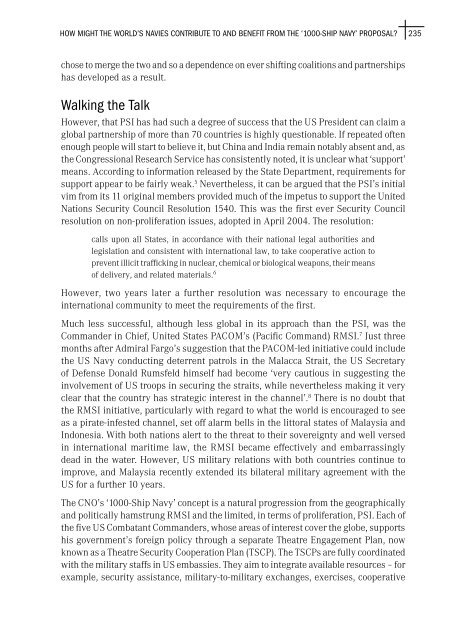Australian Maritime Issues 2007 - Royal Australian Navy
Australian Maritime Issues 2007 - Royal Australian Navy
Australian Maritime Issues 2007 - Royal Australian Navy
You also want an ePaper? Increase the reach of your titles
YUMPU automatically turns print PDFs into web optimized ePapers that Google loves.
How Might the World’s Navies Contribute to and Benefit from the ‘1000-Ship <strong>Navy</strong>’ Proposal?<br />
235<br />
chose to merge the two and so a dependence on ever shifting coalitions and partnerships<br />
has developed as a result.<br />
Walking the Talk<br />
However, that PSI has had such a degree of success that the US President can claim a<br />
global partnership of more than 70 countries is highly questionable. If repeated often<br />
enough people will start to believe it, but China and India remain notably absent and, as<br />
the Congressional Research Service has consistently noted, it is unclear what ‘support’<br />
means. According to information released by the State Department, requirements for<br />
support appear to be fairly weak. 5 Nevertheless, it can be argued that the PSI’s initial<br />
vim from its 11 original members provided much of the impetus to support the United<br />
Nations Security Council Resolution 1540. This was the first ever Security Council<br />
resolution on non-proliferation issues, adopted in April 2004. The resolution:<br />
calls upon all States, in accordance with their national legal authorities and<br />
legislation and consistent with international law, to take cooperative action to<br />
prevent illicit trafficking in nuclear, chemical or biological weapons, their means<br />
of delivery, and related materials. 6<br />
However, two years later a further resolution was necessary to encourage the<br />
international community to meet the requirements of the first.<br />
Much less successful, although less global in its approach than the PSI, was the<br />
Commander in Chief, United States PACOM’s (Pacific Command) RMSI. 7 Just three<br />
months after Admiral Fargo’s suggestion that the PACOM-led initiative could include<br />
the US <strong>Navy</strong> conducting deterrent patrols in the Malacca Strait, the US Secretary<br />
of Defense Donald Rumsfeld himself had become ‘very cautious in suggesting the<br />
involvement of US troops in securing the straits, while nevertheless making it very<br />
clear that the country has strategic interest in the channel’. 8 There is no doubt that<br />
the RMSI initiative, particularly with regard to what the world is encouraged to see<br />
as a pirate-infested channel, set off alarm bells in the littoral states of Malaysia and<br />
Indonesia. With both nations alert to the threat to their sovereignty and well versed<br />
in international maritime law, the RMSI became effectively and embarrassingly<br />
dead in the water. However, US military relations with both countries continue to<br />
improve, and Malaysia recently extended its bilateral military agreement with the<br />
US for a further 10 years.<br />
The CNO’s ‘1000-Ship <strong>Navy</strong>’ concept is a natural progression from the geographically<br />
and politically hamstrung RMSI and the limited, in terms of proliferation, PSI. Each of<br />
the five US Combatant Commanders, whose areas of interest cover the globe, supports<br />
his government’s foreign policy through a separate Theatre Engagement Plan, now<br />
known as a Theatre Security Cooperation Plan (TSCP). The TSCPs are fully coordinated<br />
with the military staffs in US embassies. They aim to integrate available resources – for<br />
example, security assistance, military-to-military exchanges, exercises, cooperative
















